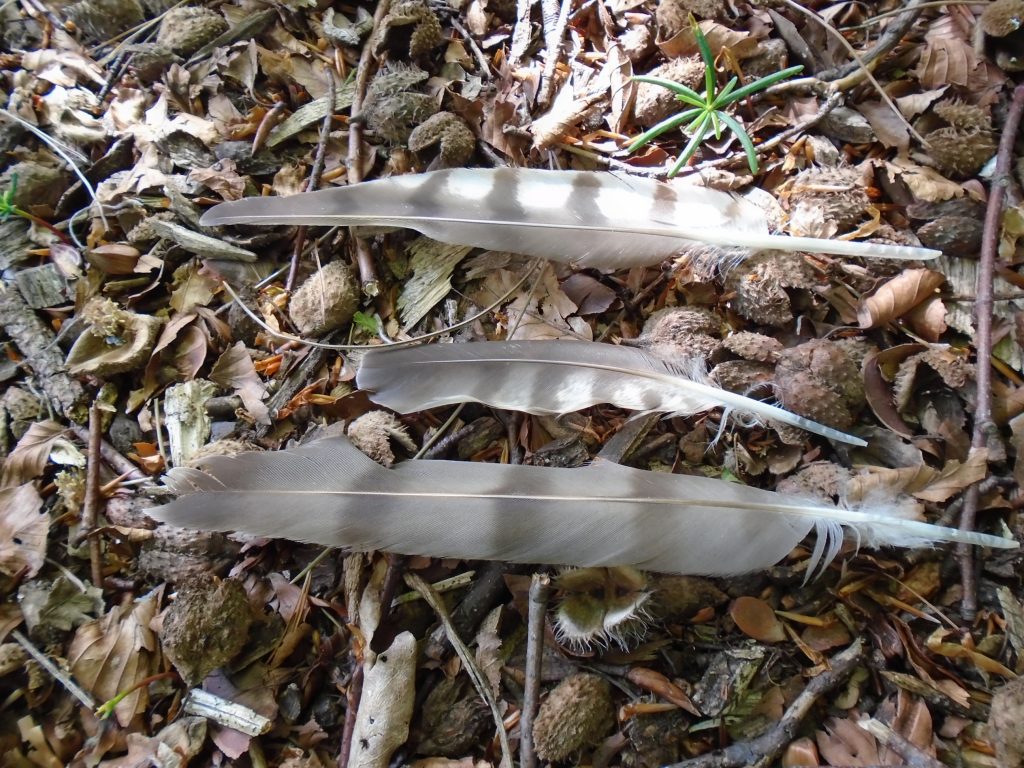Welcome to this instalment of the Botanics Sparrowhawks blog. The feathers above were found below one of the nests and Hugh Coventry, an expert on sparrowhawks who regularly visits the garden, explained to me that they were “molts”. If you happen to find any like this in the garden, please leave them as you find them as they are collected for scientific purposes. The top one is from the wing and the bottom is a tail feather. For more information on types of feathers I found a website which may be of interest:
http://www.birds.cornell.edu/AllAboutBirds/studying/feathers/feathers
There is exciting news as well! It appears that there are two nests with females on them in the garden! This is a first as far as I’ve seen although I have been informed that it has happened before in the garden making it a unique site for sparrowhawk territories which lie so close together.
Since I last posted I have been having some thoughts about the relationship between sparrowhawks and trees. This train of thought was started after I started noticing a lot of other birds nesting in the trunks of trees. I saw blue tits and woodpeckers that had both managed to nest in small holes that were made in the ring of bark produced around a fallen or cut limb of about 5 to 10 cm in diameter. It seems that some of the trees in the Botanics therefore provide multi-storey living accomodation for birds. This is an amazing example of the symbiotic relationships between the plant and animal kingdoms.
So how do the sparrowhawks benefit from the trees? Well they obviously provide the structure upon which they build their nests and broken cast-off twigs make up the material of the nest itself. Sparrowhawks favour twigs from larch as they seem to bind together the best to form the nest. As outlined above, the trees also provide nesting spaces for the birds that are the prey of the sparrowhawks and so house their food supply. And I have also seen a sparrowhawk use the topmost boughs of a tree as cover for launching an ambush on an unsuspecting pigeon which narrowly escaped with its life. However I imagine that this tactic could prove successful on other occasions.
The interaction between sparrowhawks and trees is a good illustration of the many relationships between different forms of life encompassed by biodiversity. Sparrowhawks would have to drastically change their behaviour, which could have a severe impact on their success, if trees were removed from their environment. Fortunately at the Botanics the trees are well cared for by Martyn Dickson and the arboricultural team and the habitat has excellent long-term prospects. Sparrowhawks have been living in their woodland homes for thousands of years and are well adapted to this habitat as can been seen from their amazing aerobatic skill. Branches and tree trunks are no obstacle for them as they chase their quarry through the woods utilising agile wing and tail movements and lightning fast reflexes. Sometime you may be lucky enough to witness the thrilling fly-by of a sparrowhawk while strolling through the wooded areas of the garden.
More sparrowhawk news to come and if you have any sparrowhawk stories of your own, please feel free to share them in a comment. The next exciting phase which should be occuring soon is the eggs hatching.

